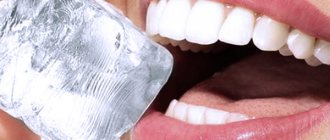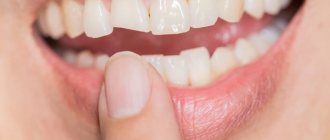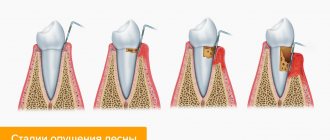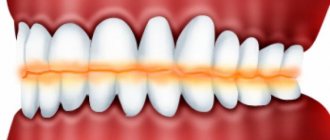It’s great when teeth don’t make themselves felt at all. You can enjoy any drinks, dishes, not be afraid of awkward movements (“biting on the wrong side”), enjoy life and delight others with a snow-white smile. However, all this applies only to healthy teeth. Any problems with the jaw immediately and dramatically reduce the quality of life, causing discomfort and pain. One of the most unpleasant and most common pathologies (according to some data, occurs in 68% of the population) is the reaction of teeth to cold and hot.
In fact, the vast majority of people experience this unpleasant sensation. These unfortunate people do not allow themselves to refresh themselves with ice cream in the heat - because the tooth reacts to cold with sharp, albeit short-term pain. They do not have the opportunity to warm up and enjoy a hot latte - the tooth reacts to hotness and gives off such an “impulse” that the whole body jumps as if from an electric shock.
Unfortunately, such a reaction rarely serves as a reason for examination by a dentist - many perceive the problem as inevitable and try to cope on their own. They limit hot and cold, use various hygiene products to reduce tooth sensitivity.
However, this is a dead-end path, which, moreover, can lead to much more difficult to eliminate consequences than a short-term attack of pain from a sip of an ice-cold cocktail. Therefore, the best way to deal with dental hypersensitivity once and for all is to make an appointment at the dentist and undergo an examination by an experienced dentist. To understand why this is necessary, it is worth finding out why the tooth generally reacts to cold and hot.
Why can teeth react to cold?
There are many reasons why discomfort and pain may occur when drinking cold or hot drinks or food. Most of them are directly related to diseases of the oral cavity, but there are also those that are not directly related to dental pathologies:
- Damage to tooth enamel.
Violation of the integrity of the outer covering of the tooth can be caused by a variety of reasons: frequent consumption of hard and dry food, which scratches the enamel during chewing; - mechanical chips;
- an incorrectly selected toothbrush (doctors recommend using medium-hard brushes for adults and soft-bristled brushes for children);
- eating foods that can negatively affect the condition of enamel (carbonated sweet drinks, sour fruits, food additives, etc.).
is one of the most common causes. The fact is that most people don't even think about the fact that they have tooth decay until a distinct black spot appears on the tooth. In fact, caries in the early stages can only be distinguished by an experienced dentist - a tiny gray dot (and this is what “young” caries looks like), if it is not examined in time and urgent measures are not taken to eliminate it, it first becomes the cause of increased sensitivity, and then acute pain.
. Untreated caries invariably leads to another, even more serious disease - pulpitis - destruction of the soft tissues of the tooth. Naturally, with pulpitis, the dental nerves are exposed, which causes acute pain when eating cold, hot, sweet or sour food.
. If the gums become inflamed, in most cases the subgingival part of the tooth, the dentin, is exposed. Dentin is completely devoid of a protective layer - enamel - therefore, at the slightest contact with cold water, food, or even just cold street air, patients invariably experience discomfort and pain.
If you suspect one of the above reasons, you should not delay visiting the dentist for long - an experienced specialist will quickly identify the problem and prescribe a course of treatment.
Reasons not related to oral diseases include the following:
- any hormonal disorders
and changes in the body. As a rule, such conditions occur while taking hormonal drugs, oral contraceptives, during pregnancy or breastfeeding; - suffered nervous shocks
, life in a state of constant stress, etc.; - deficiency of vitamins
, minerals and nutrients in the body. “Seasonal” sensitivity can often occur - when in spring and autumn, due to vitamin deficiency, many patients begin to complain of a certain discomfort after taking cold or hot; - damage to the immune system
, viral diseases; - endocrine diseases
(disorder of one or more endocrine glands).
If increased tooth sensitivity is caused by these particular pathological conditions, then no special dental treatment is required - the main treatment should be aimed at eliminating the root cause.
If, after a serving of ice cream or a glass of cold juice, you suddenly feel discomfort, which smoothly turns into acute pain, it is quite acceptable to take a tablet of a pain reliever that is suitable for you - this can be Nimessil (powder for dissolving in warm water), Aertal (tablets), Ketonov , Dexalgin.
Causes
The causes of dental hyperesthesia can be very diverse, ranging from mechanical damage to the surface of tooth enamel and ending with general disturbances in the functioning of the human body. The most common causes of enamel hyperesthesia are:
- damage to tooth enamel by short-term exposure to organic or mineral acids;
- exposure of dentinal canals as a result of carious and non-carious lesions of teeth;
- disruptions in the functioning of the endocrine system as a result of pregnancy or menopause;
- disturbances of phosphorus-calcium metabolism in the human body;
- previously suffered general or neuropsychological diseases of the human body;
- exposure to ionizing radiation on the human body;
- habit of eating a lot of sour berries, fruits, juices, fruit drinks.
Sensitive tooth enamel occurs when the dentinal tubules become exposed for one or more reasons and a variety of irritants affect the sensitivity of the pulp. In this case, even simple inhalation of cold air or brushing your teeth can cause painful sensations. Teeth in the cervical area are especially sensitive, because the enamel is thinnest there, and if the gum moves away from the tooth, it almost immediately begins to react sharply to various irritants.
Separately, we should dwell on the mechanism of hyperesthesia. As you know, dentin is penetrated by many tiny tubes - the so-called dentinal canals, in which there are processes of nerve cells that are connected to the pulp. Dentinal tubules are filled with fluid that is in constant motion. Any change in the speed of fluid movement causes a pain reaction.
If the enamel is thinned, this leads to exposure of the dentinal tubules, and under the influence of various irritants, the speed of fluid movement in the dentinal tubules constantly changes, causing acute short-term pain, as a result of which the patient complains of very sensitive teeth.
Reaction to cold after dental procedures
Often the cause of a sudden reaction of teeth to cold or hot is recent dental procedures:
- Whitening. In order to understand how this very popular procedure today affects tooth sensitivity, let us recall that whitening (especially done at home or in a suspicious clinic by an inexperienced doctor) can cause severe thinning of tooth enamel. Needless to say, abuse of the procedure invariably leads to damage to the enamel and, accordingly, causes hyperesthesia.
By the way, frequent use of highly abrasive whitening toothpastes can lead to teeth reacting to cold or hot temperatures. If you prefer to use whitening pastes, choose gentle and gentle preparations.If increased sensitivity is the result of excessive whitening, you should first stop using abrasive pastes and contact your dentist to undergo a fluoridation or remineralization procedure.
- Sealing . Most often, after conventional therapeutic treatment of deep caries or pulpitis, patients experience increased tooth sensitivity. The reason for this is the effect on the pulp and nerve endings, after which it is not recommended to drink cold or hot for a few more days. As a rule, there is no acute pain, so the patient can easily cope with the discomfort. If it suddenly turns out that after 2-3 days the sensitivity does not disappear, the discomfort gradually turns into pain, you need to urgently consult a doctor - perhaps an inflammatory process has begun, which needs to be eliminated as soon as possible.
- Prosthetics . During the installation of fixed or removable dentures, tooth enamel can also be damaged.
It is rarely possible to avoid hypersensitivity after dental procedures, so it is recommended to minimize the consumption of cold or hot drinks, ice cream, hot food, etc.
Tooth structure
The human tooth is quite complex. The crown (the outer protruding part) is covered with enamel, the hardest tissue in the body that protects the tooth from infections and mechanical damage. On the crown, immediately below the enamel, there is dentin - a durable tissue that makes up the bulk of the tooth. Dentin is pierced by dentinal tubules, which, in turn, are connected to the pulp - loose connective tissue in the tooth cavity. The pulp contains a huge number of blood and lymph vessels, many nerve endings that instantly respond to any external influences on the tooth.
Any, even the slightest damage or even thinning of the enamel leads to the fact that the influence of external influences on the pulp and the nerves located in it increases. And a tooth, even at first glance quite healthy, treated and filled, reacts with pain - for example, to hot and cold. This reaction is called hyperesthesia.
Why does a dead tooth react to cold?
Increased tooth sensitivity is the result of irritation of nerve endings. Accordingly, after removal of the nerve, the tooth should not react in any way to cold or hot. However, in practice the opposite occurs - a “dead” tooth aches, hurts and causes the patient a lot of discomfort. There may be several reasons for this:
- In fact, one of the neighboring, “living” teeth reacts to the cold, although it may seem that it is the pulpless one that hurts. In this case, you need to contact a specialist to figure out why this healthy tooth reacts to cold (damaged enamel, caries, pulpitis, etc.).
- The “dead” tooth was poorly healed. There are times when even an extremely experienced doctor, who has the most modern equipment at his disposal, cannot completely cope with pulpitis in one go due to the banal non-standard structure of the tooth canals. As a result, the nerve is not completely removed, and when you eat cold or hot food, the tooth begins to hurt. To eliminate the sensitivity of such a tooth, it is necessary to take an x-ray and consult a dentist for complete removal of the nerve.
- It also happens that the dental nerve is completely removed, but the canals are poorly sealed - in this case, an inflammatory process begins under the filling, which causes a reaction to cold.
You should also not miss the fact that the cause of a pulpless tooth’s reaction to cold or hot may be an infectious viral disease or hormonal imbalance.
Diagnostics
If a patient complains of tooth sensitivity to cold, hot, sweet and sour foods, the doctor may immediately suspect hyperesthesia. The disease can be diagnosed after a visual examination of the patient's oral cavity. During the examination, the doctor may note changes in the structure of the hard tissues of the tooth, as well as changes in the condition of the periodontium. Usually there is a decrease in hard tissue at the cutting edge (front teeth) or on the chewing surface (back teeth).
Differential diagnosis of hyperesthesia lies in the ability to distinguish the symptoms of tooth sensitivity from the symptoms of acute pulpitis. In acute pulpitis, pain is prolonged, pain occurs mainly at night. With hyperesthesia, the pain is short-term, occurs directly from chemical or thermal irritation of the tooth and goes away almost immediately.
Treatment at home
Unfortunately, getting an appointment with a good dentist can be very difficult. But what to do if you need help in the fight against increased sensitivity of teeth right now? To solve this problem, you can turn to effective folk and home remedies:
- For many years, decoctions (infusions) of herbs have been considered one of the most effective remedies. They relieve inflammation, many of them have antibacterial, soothing and healing properties. You can prepare a decoction of chamomile, oak bark, sage, oregano, calendula, and burdock. You can make an herbal cocktail - mix several dry herbs, pour boiling water and cook in a water bath for 15 minutes, cool and rinse your mouth several times a day.
- Propolis is very famous for its antibacterial properties. You can use it to prepare an alcohol tincture for mouth rinsing by pouring alcohol into a piece of propolis.
- If you are a big fan of warm milk, then the following method is created especially for you - all you need is to simply drink warm milk more often, but do not immediately swallow it, but leave it in your mouth for a while. Why does this method work? Milk contains calcium, which has a beneficial effect on tooth enamel, strengthening it, thereby reducing tooth sensitivity.
However, the surest way to get rid of increased tooth sensitivity is to use special pastes, gels and mouth rinses with fluoride. If you do get an appointment with a dentist, he will most likely suggest that you undergo a fluoridation or teeth remineralization procedure.
You should not rely entirely on folk and home remedies. They may serve as an adjunct to primary therapy rather than as the sole treatment.
Choosing toothpaste
Needless to say, you need to pay special attention to the choice of toothpaste? The first thing you need to learn is that if increased tooth sensitivity occurs, you need to give up whitening pastes (at least for a while, until this problem is finally resolved). Subsequently, such means can be used, but very carefully.
So, what to look for when choosing toothpaste for sensitive teeth:
- Choose only special toothpastes (usually manufacturers indicate this on the packaging);
- Pay attention to special medications that reduce tooth sensitivity (they are sold exclusively in pharmacies);
- It is recommended to give preference to pastes or gels with a high fluoride content - such preparations, if used regularly, restore tooth enamel, thereby coping with the problem of hypersensitivity.
Don’t forget about choosing the right toothbrush - it should be of medium hardness in order to remove food debris from the surface of the teeth without scratching the enamel.
Treatment
If a doctor has diagnosed a patient with hypersensitivity, treatment is usually prescribed depending on the cause of the disease, as well as the degree of its development. In modern dentistry, there are many techniques, so treating sensitive teeth is usually not difficult for a dentist.
- With grade 1 hyperesthesia, complex surgical or therapeutic treatment is usually not required. Sometimes it is enough to carry out a course of dental fluoridation, which consists of applying applications of calcium and fluorine salts to the diseased tooth.
- When treating stage 2 and 3 disease, application of applications is sometimes not enough; it may be necessary to cover the enamel using modern filling materials.
If the cause of hyperesthesia is a carious process, it is necessary to prepare the tooth, clean the cavity from tissues affected by caries and put a filling.
If the cause of the disease is receding gums as a result of inflammation of periodontal tissue and exposure of the cervical areas, it is necessary to carry out surgical treatment, during which the gums are lifted and cover the neck of the tooth.
When treating a generalized form of hyperesthesia, it is necessary to simultaneously prescribe drugs to normalize phosphorus-calcium metabolism in the patient's body. For this, the dentist usually prescribes calcium glycerophosphate preparations, as well as multivitamin complexes, which should be taken throughout the course of treatment for hyperesthesia.
If increased sensitivity persists after filling, it is necessary to check the quality of the filling. If the filling is placed incorrectly, its edges do not adhere tightly to the tooth enamel, and food debris can get into the resulting gap, causing pain. In this case, it is necessary to refill the tooth. Sometimes sensitivity after caries treatment may indicate the presence of a chronic inflammatory process inside the tooth pulp.
If you experience tooth sensitivity after cleaning or whitening, this may indicate thinning tooth enamel.
If there are no other carious and non-carious diseases, a good effect in the treatment of hyperesthesia can be achieved using electrophoresis procedures with a solution of calcium glycerophosphate. Another new and effective remedy is to coat the enamel surface with a special varnish containing calcium and sodium fluorides. Thanks to these measures, it is possible to get rid of sensitivity for a long time.
Whitening sensitive teeth should be done with extreme caution, only in a specialized clinic after consultation with an experienced specialist. After all, during the whitening process, tooth enamel can also become thinner and more sensitive. The doctor must select the most gentle whitening technology, as a result of which the enamel will not be damaged.
Dental sensitivity and braces are also interconnected; sometimes patients experience increased sensitivity after removing braces; to eliminate this sensitivity, a course of applications of calcium and fluoride salts, as well as coating the surface of the tooth enamel with varnish with calcium and sodium fluorides is usually sufficient.
If sensitivity occurs after brushing, it is necessary to use special toothpastes with a high content of fluoride and calcium. Today you can choose a good pasta, but you should entrust this matter to professionals. No one can select a toothpaste specifically for your teeth better than a dentist.
Treatment in dentistry
Few people manage to cope with the problem of increased tooth sensitivity at home. Basically, to solve this problem, sooner or later they turn to professionals, who, in turn, offer radical methods of combating hyperesthesia:
- Fluoridation
(simple or deep). A special fluoride-containing composition is applied to the teeth, which helps strengthen the enamel. Simple fluoridation requires several procedures, while deep fluoridation is performed in one visit to the doctor, and is more effective. - Remineralization
is the treatment of teeth with special compounds that can compensate for the deficiency of minerals in the enamel. - Coating with special dental varnishes
. These preparations seal the surface of the tooth, covering it with a dense film, thereby ensuring the strength of the enamel and preventing its further destruction.
If you suddenly feel that your teeth are reacting to cold or hot, immediately contact an experienced specialist who will carry out all the necessary manipulations to solve your problem:
- Initial examination. Detection of dental diseases (caries, pulpitis, gum disease, etc.).
- Drawing up a clear treatment plan.
- Sanitation of the oral cavity, elimination of all existing foci of infection.
- Removal of plaque and tartar (professional cleaning).
- Treatment of enamel with a selected composition (fluoridation, remineralization, varnishing).
After the procedure, the doctor will recommend using only special pastes, reviewing your diet by adding more foods rich in calcium and fluoride, and, of course, visiting the dentist at least once every 6 months.
Is it possible to cure sensitivity on your own?
If the process is not too advanced, you can cope with hyperesthesia at home. First, you should review your diet and remove from it all those foods that cause pain: sour fruits and juices, hot drinks and dishes, iced cocktails and soda, sweets and ice cream. This alone can soothe aching teeth for a long time.
To speed up the process, you can purchase special gels and ointments, for example, Fluokal, GS Tooth Mousse, President. Their task is to create a thin film on the surface of the tooth that will protect the enamel from destruction by acids and close the exposed dentin tubules. The dental film Diplen Denta F also showed good results. It is fixed on the teeth for 7-8 hours so that the film has time to saturate the enamel with fluoride.
An excellent folk remedy for tooth sensitivity is tea tree oil. To treat hyperesthesia, 3 drops of it should be diluted in a glass of warm water and rinsed 1-2 times a day. After such rinses, it is important not to eat for 1.5-2 hours.
Self-treatment of tooth sensitivity can be quite effective. But only if the cause of the problem is thinning of the enamel. If the measures taken do not produce any results over the course of several days, and the pain intensifies, you should immediately consult a doctor.
Choosing toothpaste
For increased tooth sensitivity, desensitizing pastes containing a lot of fluorine, potassium and calcium are recommended. In addition, they contain components that fill microcracks in the enamel and restore its structure. Sometimes the composition contains a long-acting anesthetic. Such pastes can simply be spread on the teeth to get a quick pain-relieving effect.
The best on the Russian market are SILCA Complete Sensitive and LACALUT Extra Sensitive, Sensodyne F and Blendamed Pro-Expert. The popularity of these products has played a cruel joke on them - there are a huge number of fakes on store shelves. Therefore, you need to buy medicinal paste only at the pharmacy.
Despite the fact that the use of desensitizing pastes is no different from the use of conventional ones, the former are classified as medicinal. Therefore, you cannot use them constantly, without a break: a course of 4-5 weeks is enough, after which you need to return to regular hygienic toothpaste.
In order for the components of the medicinal paste to bring maximum benefit, you need to brush your teeth with special care, and for at least 3-5 minutes 2 times a day. Brushes for hyperesthesia should be selected with medium hardness. So that they can successfully cope with the removal of food debris, but cannot injure the gums.
15% discount on emergency care for acute pain!
Moscow
How does pain occur?
People with increased tooth sensitivity know for sure that if the problem is not addressed in time, then over time it will cause a lot of trouble.
The main cause of hyperesthesia is thinning or damage to the enamel. Accordingly, the thinner this protective layer, the more often and stronger the teeth react to cold or hot. Gradually, mild discomfort turns into severe pain - after all, after the tooth enamel is destroyed, the soft tissues of the tooth, which contain the nerve endings, undergo decomposition. Irritation of the nerves invariably leads to sore teeth, it becomes painful for the patient to chew, drink, and even pain may occur when air gets into the mouth.
Hypersensitivity after tooth filling and preparation for dentures
Most often in dental practice, increased sensitivity is observed after filling. Patients come to the clinic with complaints of sensitivity, especially to cold, without precise localization of pain. Upon visual examination, sensitivity in the basal part is not detected. There is no evidence of open pulp or caries on the x-ray.
The causal unit, however, can be identified. To do this, use ice, which, wrapped in a paper napkin, is applied to the cheek area or to the surface of the tongue. An area with a violation of integrity in hard tissues is a source of irritation, so severe pain occurs in the tooth. Removing all filling material will allow you to detect the break.
The reason for increased susceptibility, often to cold or too hot food, may be the appearance of microgaps between the filling and the hard tissues of the tooth due to compression of the composite material. The gap formed in the cavity near the root canals opens up space for the movement of dentinal fluid, thereby causing a response from the nerve endings of the pulp.
The area of contact of the material with the walls of the internal space of the tooth can also contribute to the formation of hypersensitivity after filling. Since filling composites have a high elasticity index, they cause stress in the contact layer “filling - hard dental tissue”. The tension in the tooth tissues is greater in cases where the surface of the restoration in contact with the walls is extensive.
After preparation (grinding) of a tooth for prosthetic structures and microprostheses, normal sensitivity is observed, which is characterized by mild pain. If there is no inflammatory process in the pulp, the pain is considered causative and disappears a few minutes after the drill stops working. If hypersensitivity persists for a long time (2 or more days after the procedure), treatment of pulpitis is required.
Forms and degrees of hyperesthesia
There are 3 stages of development of the problem:
- While eating cold food, the patient feels slight discomfort, which quickly passes and is forgotten. But it is important to understand that this is only the first call, which you definitely need to listen to. After all, it is obvious that there is already a violation of the integrity of the enamel, and the sooner measures are taken to restore it, the faster the problem of tooth sensitivity will be solved.
- Mild discomfort turns into pain. While this pain is quite tolerable, it does not occur immediately, gradually intensifies, but passes within a short time (provided that the irritant is eliminated - cold drink or food). Often such teeth react not only to cold, but also to hot, sweet, sour, spicy, salty, etc.
- The third stage - upon contact with cold or hot, spicy or sweet foods, the tooth immediately begins to hurt, the pain intensifies and does not stop even after the irritant is eliminated.
In addition, there are also several forms of hyperesthesia:
- Limited.
An individual tooth reacts to cold. - Generalized.
The entire dentition suffers from increased tooth sensitivity.
Despite the fact that hyperesthesia is a fairly common phenomenon and many patients treat this condition as normal, in fact, increased tooth sensitivity can cause the development of many other dental diseases. Therefore, you should not delay contacting the dentist.
Do not ignore preventive visits to the dentist.
It is enough to visit a specialist 1 – 2 times a year, which will allow you to promptly identify any dental problem at an early stage of development. This means that its elimination will be quick, easy and without complications.
By clicking the “request a call” button you agree to the personal data processing policy.
Why do teeth hurt from cold and hot?
The most obvious causes of pain when eating cold and hot foods are:
- Regular exposure of enamel to acids
. Remember, do you eat too many lemons and oranges, do you like sweet carbonated drinks and especially Coca-Cola? - Microscopic enamel injuries
. Tiny cracks are not uncommon among those who like to chew nuts, seeds, caramels, and other hard foods. For the same reason, the habit of biting your nails and clenching your teeth is also dangerous for your teeth. - Abuse of whitening pastes
. They can be used in short courses. It’s better to seek help from professionals - home whitening does not provide a long-lasting effect, but it seriously damages the enamel. - Using a brush that is too hard
. Such a personal hygiene instrument provokes atrophy of the soft tissues of the gums and ultimately leads to exposure of the neck of the tooth. - Development of caries
. Hyperesthesia in this case signals the development of erosion and the appearance of wedge-shaped defects. - Exposure of the neck of the tooth
. There is no enamel at the base of the tooth, so patients with this problem react particularly acutely to cold and hot foods, and even to a flow of cold air when inhaled.
Body problems that, at first glance, are in no way related to dentistry can also deprive you of the pleasure of eating ice cream. These include:
- Endocrine disorders
. Problems with hormones change the acid-base balance in the mouth, which in turn affects the condition of the enamel. - Acute respiratory diseases
. Bacteria and viruses during acute respiratory viral infections, acute respiratory infections and influenza can easily provoke hyperesthesia. One thing is good: with recovery, excessive tooth sensitivity also goes away completely. - Bacterial gastritis
. Increased acidity causes heartburn, which in turn increases acidity in the mouth. A too acidic environment inevitably leads to the destruction of enamel and the development of hyperesthesia. - Stress
. When we worry about problems in the family or at work, we unconsciously trigger a complex mechanism, one of the manifestations of which is increased nervous excitability. They respond with excessive sensitivity to global stress and nerve roots in the tooth. - Lack of magnesium, calcium or phosphorus
. Without getting enough of these minerals, tooth enamel begins to break down, nerves become exposed, and sensitivity to the temperature of food and drinks increases. - Toxicosis during pregnancy
. The first trimester is a difficult period during which a woman often develops stomatitis and periodontal disease, and all dental problems, including hyperesthesia, worsen.
Some medications, such as hormonal contraceptives, can also cause problems. As well as constant inhalation of chemicals, which is typical for workers in the food and chemical industries. Situations in which teeth react only to hot or only to cold deserve special attention.
A painful reaction only to hot foods is most often a sign of an exposed nerve. By the time pain appears, the culprit tooth is already practically dead due to lack of tissue nutrition. But decomposition inside the tooth is in full swing with the simultaneous release of methane gas. When eating hot food, methane expands and puts pressure not only on the inflamed nerve, but also on the main one, passing through the entire dentition. Thus, due to the disease of one tooth, hyperesthesia of the entire jaw can develop.
The cause of tooth sensitivity to cold foods, drinks and even air often lies in inflammation of the soft tissues of the tooth - pulpitis. And also in the exposure of the neck: in those areas that react to cold, you can usually easily see the peeling of the gums from the neck of the tooth.
What complications may arise?
If the disease is not treated, it will certainly cause very extensive complications. Hyperesthesia is no exception. If we take into account the fact that the reaction of teeth to cold and hot can be the result of a variety of pathologies, then this problem needs to be solved as quickly as possible, without waiting for these complications to make themselves felt.
Untreated hyperesthesia at an early stage eventually leads to severe toothaches - patients complain of the inability to eat, and feel pain when air enters the mouth. At stage 3, it is much more difficult to cope with the problem - after all, by this time the enamel is already quite badly destroyed, which is why numerous carious cavities are formed, etc., and drastic measures may be required.
Enamel is the protective layer of the tooth. When it is abraded, deformed or mechanically damaged, soft tissue becomes vulnerable to a huge number of bacteria. Therefore, you should not put off going to the dentist at the first signs of a reaction to cold or hot foods.
How to get rid of hyperesthesia
As you can see, the reaction of teeth to hot and cold is just the tip of the iceberg. And, of course, the removal of this discomfort should begin with a visit to the dentist and consultation with a dentist. It will not be possible to cope with the problem at home, and if left untreated, it will lead to tooth loss.
Professional diagnosis of the cause of hyperesthesia is necessary to select the correct method of dental treatment - medicinal, hygienic, physiotherapeutic or surgical.
Depending on what led to the pathology, the doctor may choose one or more types of treatment:
- Mineralization is the saturation of enamel with substances rich in potassium, fluorine, phosphorus and other minerals.
- Fluoridation of enamel - coating it with fluoride-containing preparations.
- Fissure sealing is the sealing of grooves on the chewing surface with a sealant.
- Installation of dentures, crowns, veneers if necessary.
- Filling in the presence of a carious process.
- Treatment of periodontitis and surgical removal of gum pathology. Most often, this is its raising if the onset of the disease is due to receding gums and exposure of the cervical area.
As a rule, if hyperesthesia is in the first stage, complex treatment is not required. Fluoridation of teeth and their mineralization is sufficient. Most of the above procedures are chosen by dentists if the process has already reached stages 2 and 3.
Prevention of tooth sensitivity
A few decades ago, it was possible to escape from increased sensitivity of teeth only with folk remedies, but today there are a lot of special drugs that help in the prevention and treatment of this pathological condition - these are toothpastes, brushes and rinses, which, when used regularly, help cope with increased sensitivity. Based on the fact that the composition of all drugs is different, experts recommend changing the medicinal paste or rinse from time to time. But it is better to avoid using whitening pastes.
In addition, there are a number of standard recommendations, the implementation of which will protect the enamel from damage:
- Regular, thorough oral hygiene (2 times a day - morning and evening, during the day it is recommended to rinse your mouth after each meal). It is advisable to use a brush of medium hardness.
- The diet should be well balanced - vitamins, minerals, nutrients. Be sure to include dairy products, fish, and meat in your menu. But it is better to limit sweets and spicy foods as much as possible. Also, to preserve the integrity of the enamel, try to avoid dry solid foods - crackers, seeds, etc., as well as carbonated drinks.
- Consult your doctor and choose the appropriate course of vitamins and minerals for yourself.
- Don't forget to visit your dentist regularly - for a routine examination you need to make an appointment at least once every six months.
If, despite all preventive measures, your teeth react to cold or hot, be sure to consult a doctor - perhaps the problem lies deeper and only an experienced specialist can identify its cause.
Author: Elena Grunina Dentist-therapist, endodontist. Work experience more than 9 years. The information is for reference only. Before treatment, consultation with a doctor is necessary.
What needs to be done to prevent hyperesthesia from occurring at all?
Timely prevention will reduce the likelihood of developing any pathological processes in the oral cavity and protect you from serious and financially costly problems.
For prevention:
- Use suitable toothbrushes and toothpastes that do not contain abrasives. Brush your teeth at least twice a day, and do it properly. Don't neglect dental floss and mouthwash.
- Don’t forget - professional teeth cleaning in a dental setting should take place at least once every 6-12 months.
- Strengthen your immune system, stop smoking, coffee, foods high in sugar and acids.
- “Fortify” your diet - your daily meals should contain a sufficient amount of vitamins and minerals. If this is not possible, use pharmacy vitamin-mineral complexes.
And, of course, monitor the health of your teeth and your entire body, undergo a medical examination, and regularly visit a therapist and dentist. A disease noticed in time will save you from many troubles.
Initial measures to eliminate signs of hyperesthesia
To eliminate unpleasant sensations, the doctor primarily gives the patient the following recommendations:
- exclude predisposing factors;
- do not consume food acids, that is, refuse those products that contain them;
- Carry out hygienic teeth cleaning long before or after meals;
- Reduce the time you spend brushing your mouth to one minute and use a soft-bristle brush.
The patient's teeth are treated with desensitizers. They reduce the sensitivity of teeth of various etiologies by sealing the dentinal tubules. The use of special toothpastes is prescribed.
When the root and neck of a tooth are exposed, mucogingival surgery (vestibuloplasty, etc.) is used to correct gum recession. During surgery, the soft structures of the oral cavity are moved to those areas that require restoration.
For pulpitis, the doctor resorts to pulpotomy. During a dental operation, the pulp is partially amputated using a vital method. At the same time, that part of it that is located in the root canal remains viable.
If sensitivity to irritants persists, additional diagnostics are carried out to exclude chronic pain syndrome, and a more effective treatment plan is drawn up.
Tooth hurts when biting
Pain in the tooth that appears when pressing and biting food indicates the development of periodontitis. The periodontium is the tissue that surrounds the root of the tooth and holds the tooth in the jaw.
Periodontitis can be acute, or it can have a chronic, practically asymptomatic course. In any case, if you suspect periodontitis, you should consult a doctor and undergo the necessary treatment. If this is not done, then over time the teeth begin to loosen and fall out.
- If the process is acute, then the pain when pressing and biting can be intense and be accompanied by other symptoms, such as pain in the area of the tooth and the adjacent area of the gum, the sensation of an “overgrown tooth,” inflammation and suppuration of the gum tissue with the formation of gumboil.
- A chronic process can make itself felt only occasionally through unexpressed discomfort when biting. The appearance of pain and discomfort will indicate an exacerbation of the process, which in most cases is observed with a decrease in immunity.
What to do if your tooth hurts?
A toothache is a good reason to visit the dentist as soon as possible.
During your visit to the doctor, the following factors will be important:
- when the pain appears, how intense is it, does only the tooth hurt or the pain spreads to neighboring areas and affects other parts of the face;
- other symptoms that appeared simultaneously with the pain, joined later or preceded its appearance;
- previous dental treatment and the time frame in which it was performed.
You can also use all these factors for self-diagnosis in order to provide yourself with the necessary help in cases where there is no way to urgently see a doctor.











